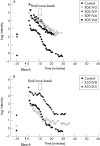Genotype-phenotype correlation in British families with X linked congenital stationary night blindness
- PMID: 14609846
- PMCID: PMC1771890
- DOI: 10.1136/bjo.87.11.1413
Genotype-phenotype correlation in British families with X linked congenital stationary night blindness
Abstract
Aim: To correlate the phenotype of X linked congenital stationary night blindness (CSNBX) with genotype.
Methods: 11 CSNB families were diagnosed with the X linked form of the disease by clinical evaluation and mutation detection in either the NYX or CACNA1F gene. Phenotype of the CSNBX patients was defined by clinical examination, psychophysical, and standardised electrophysiological testing.
Results: Comprehensive mutation screening identified NYX gene mutations in eight families and CACNA1F gene mutations in three families. Electrophysiological and psychophysical evidence of a functioning but impaired rod system was present in subjects from each genotype group, although the responses tended to be more severely affected in subjects with NYX gene mutations. Scotopic oscillatory potentials were absent in all subjects with NYX gene mutations while subnormal OFF responses were specific to subjects with CACNA1F gene mutations.
Conclusions: NYX gene mutations were a more frequent cause of CSNBX than CACNA1F gene mutations in the 11 British families studied. As evidence of a functioning rod system was identified in the majority of subjects tested, the clinical phenotypes "complete" and "incomplete" do not correlate with genotype. Instead, electrophysiological indicators of inner retinal function, specifically the characteristics of scotopic oscillatory potentials, 30 Hz flicker and the OFF response, may prove more discriminatory.
Figures





Similar articles
-
Mutations in the CACNA1F and NYX genes in British CSNBX families.Hum Mutat. 2003 Feb;21(2):169. doi: 10.1002/humu.9106. Hum Mutat. 2003. PMID: 12552565
-
A novel p.Gly603Arg mutation in CACNA1F causes Åland island eye disease and incomplete congenital stationary night blindness phenotypes in a family.Mol Vis. 2011;17:3262-70. Epub 2011 Dec 15. Mol Vis. 2011. PMID: 22194652 Free PMC article.
-
Genotype and phenotype of 101 dutch patients with congenital stationary night blindness.Ophthalmology. 2013 Oct;120(10):2072-81. doi: 10.1016/j.ophtha.2013.03.002. Epub 2013 May 25. Ophthalmology. 2013. PMID: 23714322
-
[Establishment of the concept of new clinical entities--complete and incomplete form of congenital stationary night blindness].Nippon Ganka Gakkai Zasshi. 2002 Dec;106(12):737-55; discussion 756. Nippon Ganka Gakkai Zasshi. 2002. PMID: 12610835 Review. Japanese.
-
[Molecular genetic study of congenital stationary night blindness].Nippon Ganka Gakkai Zasshi. 2004 Nov;108(11):665-73. Nippon Ganka Gakkai Zasshi. 2004. PMID: 15584351 Review. Japanese.
Cited by
-
Clinical and Genetic Characteristics of Korean Congenital Stationary Night Blindness Patients.Genes (Basel). 2021 May 21;12(6):789. doi: 10.3390/genes12060789. Genes (Basel). 2021. PMID: 34064005 Free PMC article.
-
Photopic ON- and OFF-responses in complete type of congenital stationary night blindness in relation to stimulus intensity.Doc Ophthalmol. 2008 Jul;117(1):37-46. doi: 10.1007/s10633-007-9101-x. Epub 2007 Nov 18. Doc Ophthalmol. 2008. PMID: 18026866
-
Mutations in CABP4, the gene encoding the Ca2+-binding protein 4, cause autosomal recessive night blindness.Am J Hum Genet. 2006 Oct;79(4):657-67. doi: 10.1086/508067. Epub 2006 Aug 23. Am J Hum Genet. 2006. PMID: 16960802 Free PMC article.
-
ISCEV extended protocol for the photopic On-Off ERG.Doc Ophthalmol. 2018 Jun;136(3):199-206. doi: 10.1007/s10633-018-9645-y. Epub 2018 Jun 22. Doc Ophthalmol. 2018. PMID: 29934802 Free PMC article.
-
Two Novel NYX Gene Mutations in the Chinese Families with X-linked Congenital Stationary Night Blindness.Sci Rep. 2015 Aug 3;5:12679. doi: 10.1038/srep12679. Sci Rep. 2015. PMID: 26234941 Free PMC article.
References
-
- Schubert G, Bornscein H. Beitrag zur Analyse des menschlichen Elektroretinogramms. Ophthalmologica 1952;123:396–412. - PubMed
-
- Bornschein H, Vukovich B. Das Elektroretinogramm bei mangelhemeralopie. Albrecht von Graefes Arch klin Ophthalmol 1953;153:484–7. - PubMed
-
- Miyake Y, Yagasaki K, Horiguchi M, et al. Congenital stationary night blindness with negative electroretinogram. A new classification. Arch Ophthalmol 1986;104:1013–20. - PubMed
-
- Bech-Hansen NT, Boycott KM, Gratton KJ, et al. Localization of a gene for incomplete X-linked congenital stationary night blindness to the interval between DXS6849 and DXS8023 in Xp11.23. Hum Genet 1998;103:124–30. - PubMed
-
- Strom TM, Nyakatura G, Apfelstedt-Sylla E, et al. An L-type calcium-channel gene mutated in incomplete X-linked congenital stationary night blindness. Nat Genet 1998;19:260–3. - PubMed
Publication types
MeSH terms
Substances
Associated data
- Actions
- Actions
- Actions
- Actions
Grants and funding
LinkOut - more resources
Full Text Sources
Research Materials
